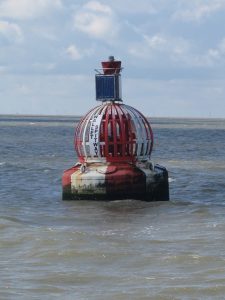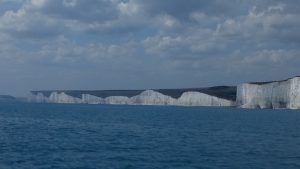When we asked a Brightlingsea sailor how best to cross the Thames Estuary, he replied: ‘Don’t start from here, go from Harwich!’ We weren’t about to backtrack just to get a better route, so a little planning was needed. The sandbanks radiate out like fingers, and many of them dry at LW, apparently like solid concrete. The plan was to depart at LW, get to the middle close to HW and accept a bit of contrary tide at the end down towards Ramsgate. Ian in ‘Shades of Grey’ kept company, relying on us for depths.
We struck out eastwards at first, buoy-hopping past a wind farm, then turned SE towards Foulger’s Gat, which took us close past some of the vast wind turbines. I can report that they have no effect on the wind in our sails, although I wouldn’t want to get too close.
Lowest depths way out at sea were about 2 metres – how on earth did anyone navigate these waters before all the buoyage was put here? The answer seems to lie in the number of wreck symbols on the chart….
Once past the sands and shallows it was a case of dodging the big ships going in and out of the Thames from the continent. Then Ian took an inshore route while we persisted on a more direct line to North Foreland. The tide steadily reduced our speed, and we could see that closer inshore its effect was much less. As we closed the shore we could see Ian ahead, motoring now in the lumpy wind against tide, down towards the entrance channel for Ramsgate. Then we started to catch him up – only later learning that one of his engines had failed again. We were overtaken by a bunch of large and very fast motor cats, service boats for the turbines, but finally made it into the harbour without mishap.
Although we were allocated a berth in among the finger pontoons, we decided instead to take up an alongside berth on the outside pontoon, claiming – truthfully – that we would find it difficult to manoeuvre in the very tight space inside. It is interesting how some marinas are generous in their spacing and others seem to cram pontoons so closely together that even the monohulls find it challenging. The Berth Manager allowed us to stay where we were, as long as we didn’t mind someone rafting up.
On our second night we inadvertently turned into the party boat…. Pol from Belgium came aboard for a drink and some strawberries, then a Dutch boat arrived after dark, came alongside and joined in the fun. All we lacked was a string of party lights (NB for next trip!).
Ramsgate itself was rather attractive, with arches occupied by chandlers, cafes and motorbike collectors cut into the wall holding back the cliff, and splendid Victorian buildings higher up. One of these is the Royal Temple Yacht Club, very much a London-based club once boasting Edward Heath as a member, and we were told the Queen herself had once dined there. The collection of silverware was truly stupendous.
After Ramsgate it was a short hop to Dover, quite a different sort of place. Big ferries come in and out every 5 or 10 minutes, and little ones have to call up for permission to enter and scuttle out of the way. They are currently redeveloping the marinas at Dover, so it is all a bit rundown and temporary. At first they said they didn’t have room for us at all, but squeezed us in on the hammerhead of a pontoon with strict instructions not to take up more than half of it. Needless to say, no one else arrived… Dover was particularly notable for the miasma of yellowish pollution visible above the town and reaching out to sea. No surprise, given the density of traffic.
Next leg was to Brighton, a longish one, but unusually for this trip there was some great wind at first, giving us a 9 knot reach. Then, true to form, after a couple of hours it died away, and we motored the rest. Past Dungeness Point, visible from a great distance thanks to the nuclear reactors which dwarf the two lighthouses.
I couldn’t quite make out the little bungalow at Lydd where I spent several childhood holidays. The cliffs at Beachy Head and the Seven Sisters (we counted eight!) beyond are truly something to behold, a real treat, incredibly white and vertical, with the lighthouse slightly incongruously at sea level (it would be lost in the mist on top of the cliff).
Brighton Marina was built right off the beach, so it has no natural defences. I understand the entrance can be wicked in some conditions, but for us it was no problem to get in, and we were kindly allocated an easy berth not far from the entrance. The marina is the largest in the UK with 1600 berths and a slightly confusing numbering system….!














